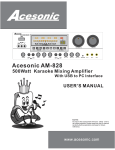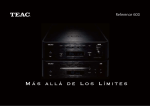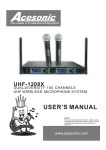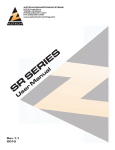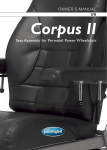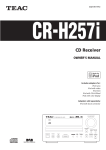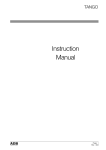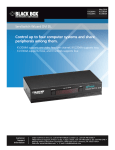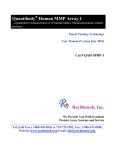Download Teac T-H300 2 Channels Tuner - T
Transcript
Z 9A09878900 CQX1A860Z T-H300DAB DAB/AM/FM Stereo Tuner OWNER’S MANUAL IMPORTANT(for U.K.Customers) DO NOT cut off the mains plug from this equipment. If the plug fitted is not suitable for the power points in your home or the cable is too short to reach a power point, then obtain an appropriate safety approved extension lead or consult your dealer. If nonetheless the mains plug is cut off, remove the fuse and dispose of the plug immediately, to avoid a possible shock hazard by inadvertent connection to the mains supply. If this product is not provided with a mains plug, or one has to be fitted, then follow the instructions given below: IMPORTANT. DO NOT make any connection to the larger terminal which is marked with the letter E or by the safety earth symbol | or coloured GREEN or GREEN-and-YELLOW. Contents Thank you for choosing TEAC. Read this manual carefully to get the best performance from this unit. Important (for U.K. Custmers) . . . . . . . . . . . . . . . . . . . . . . 2 Before Use . . . . . . . . . . . . . . . . . . . . . . . . . . . . . . . . . . . . . . 3 Remote Control Unit . . . . . . . . . . . . . . . . . . . . . . . . . . . . . . 3 Connection . . . . . . . . . . . . . . . . . . . . . . . . . . . . . . . . . . . . . . 4 Connecting Antennas . . . . . . . . . . . . . . . . . . . . . . . . . . . . . 6 Names of Each Control . . . . . . . . . . . . . . . . . . . . . . . . . . . . 8 About Digital Audio Broadcasts . . . . . . . . . . . . . . . . . . . 10 Setting up your DAB Tuner . . . . . . . . . . . . . . . . . . . . . . . 10 Using the Channel List . . . . . . . . . . . . . . . . . . . . . . . . . . . 11 Using Function Control The wires in the mains lead on this product are coloured in accordance with the following code: Station order . . . . . . . . . . . . . . . . . . . . . . . . . . . . . . . . 12 Sig error rate . . . . . . . . . . . . . . . . . . . . . . . . . . . . . . . . 13 BLUE : NEUTRAL BROWN : LIVE As these colours may not correspond with the coloured markings identifying the terminals in your plug proceed as follows: Preset tune . . . . . . . . . . . . . . . . . . . . . . . . . . . . . . . . . . 13 Sw version . . . . . . . . . . . . . . . . . . . . . . . . . . . . . . . . . . 14 DRC value . . . . . . . . . . . . . . . . . . . . . . . . . . . . . . . . . . . 14 Manual tune . . . . . . . . . . . . . . . . . . . . . . . . . . . . . . . . . 15 Auto Tuning . . . . . . . . . . . . . . . . . . . . . . . . . . . . . . . . . . . . . 15 The wire which is coloured BLUE must be connected to the terminal which is marked with the letter N or coloured BLACK. The wire which is coloured BROWN must be connected to the terminal which is marked with the letter L or coloured RED. Listening to FM/AM . . . . . . . . . . . . . . . . . . . . . . . . . . . . . . 17 Presetting . . . . . . . . . . . . . . . . . . . . . . . . . . . . . . . . . . . . . . 18 RDS . . . . . . . . . . . . . . . . . . . . . . . . . . . . . . . . . . . . . . . . . . . . 19 PTY Search. . . . . . . . . . . . . . . . . . . . . . . . . . . . . . . . . . . . . . 20 When replacing the fuse only a correctly rated approved type should be used and be sure to re-fit the fuse cover. PTY Programmes . . . . . . . . . . . . . . . . . . . . . . . . . . . . . . . . 21 IF IN DOUBT — CONSULT A COMPETENT ELECTRICIAN. Specifications . . . . . . . . . . . . . . . . . . . . . . . . . . . . . . . . . . . 22 CAUTION The product shall not be exposed to dripping or splashing and that no object filled with liquids, such as vases, shall be placed on the product. Do not install this equipment in a confined space such as a book case or similar unit. 2 Changing Display Settings . . . . . . . . . . . . . . . . . . . . . . . . 16 Factory Reset . . . . . . . . . . . . . . . . . . . . . . . . . . . . . . . . . . . 21 Sleep Timer . . . . . . . . . . . . . . . . . . . . . . . . . . . . . . . . . . . . . 22 Troubleshooting . . . . . . . . . . . . . . . . . . . . . . . . . . . . . . . . . 23 This symbol means that the product is double insulated and you do not need an earth connection This symbol means that this product keeps to the European safety and electrical interference directives Before Use Read this before operation < The voltage supplied to the unit should match the voltage as printed on the rear panel. If you are in any doubt regarding this matter, consult an electrician. < Choose the installation location of your unit carefully. Avoid placing it in direct sunlight or close to a source of heat. Also avoid locations subject to vibrations and excessive dust, heat, cold or moisture. < Do not place the unit on the amplifier/receiver. < Do not open the cabinet as this might result in damage to the circuitry or electrical shock. If a foreign object should get into the set, contact your dealer. < When removing the power plug from the wall outlet, always pull directly on the plug, never yank the cord. < Do not attempt to clean the unit with chemical solvents as this might damage the finish. Use a clean, dry cloth. Remote Control Unit The provided Remote Control Unit allows the unit to be operated from a distance. When operating the remote control unit, point it towards the REMOTE SENSOR on the front panel of the unit. < Even if the remote control unit is operated within the effective range, remote control operation may be impossible if there are any obstacles between the unit and the remote control. < If the remote control unit is operated near other appliances which generate infrared rays, or if other remote control devices using infrared rays are used near the unit, it may operate incorrectly. Conversely, the other appliances may operate incorrectly. Battery Installation 1 Remove the battery compartment cover. 2 Insert two “AAA“ (R03, UM-4) dry batteries. Make sure that the batteries are inserted with their positive “+“ and negative “_“ poles positioned correctly. 3 Close the cover. < Keep this manual in a safe place for future reference. Maintenance If the surface of the unit gets dirty, wipe with a soft cloth or use diluted mild soap liquid. Be sure to remove any excess completely. Do not use thinner, benzine or alcohol as they may damage the surface of the unit. Battery Replacement If the distance required between the remote control unit and main unit decreases, the batteries are exhausted. In this case replace the batteries with new ones. Precautions concerning batteries CAUTION Regarding Placement To maintain proper ventilation, be sure to leave a space around the unit (from the largest outer dimensions including projections) equal to, or greater than, shown below. Left and Right Panels : 10 cm Rear Panel : 5 cm Top Panel : 2 cm < Be sure to insert the batteries with correct positive “+“ and negative “_“ polarities. < Use batteries of the same type. Never use different types of batteries together. < Rechargeable and non-rechargeable batteries can be used. Refer to the precautions on their labels. < When the remote control unit is not to be used for a long time (more than a month), remove the batteries from the remote control unit to prevent them from leaking. If they leak, wipe away the liquid inside the battery compartment and replace the batteries with new ones. < Do not heat or disassemble batteries and never dispose of old batteries by throwing them in a fire. 3 Connection Digital recorder/decoder DIGITAL IN OPTICAL B T-H300DAB A A-H300 or other amplifier 4 D C CAUTION Turn off the power of all the equipment before making connections. Read instructions of each component you intend to use with this unit. < Be sure to insert each plug securely. To prevent hum and noise, do not bundle the connection cords with the power cord. A AUDIO OUT jack Analogue 2-channel audio signal is output from this jack. Connect the component with RCA pin cable. AUDIO OUT (T-H300DAB) w TUNER IN (amplifier) Make sure to connect : white plug w white jack (L: left) red plug w red jack (R: right) D REMOTE CONTROL jack If you have TEAC Reference 300 series, Convenient sysytem control operations are possible. < By pressing the POWER STANDBY button of the Reference 300 series Amplifier/Receiver, you can switch ON/standby all the unit connected with remote control cord. < When you press the PLAY button of the source, the INPUT SELECTOR of the Reference 300 series Amplifier/Receiver will be set to the source automatically. < The source you select by the INPUT SELECTOR of the Reference 300 series Amplifier/Receiver will start playback automatically. < When you turn ON the system, the source that was selected last time will start playback automatically. < You can use the system remote control unit to operate all the unit connected with remote control cords. Connect the remote control jack (A or B) of each component with remote control cords. B DIGITAL OUT terminal DAB’s digital audio signal is output from this terminal. If you want to record digitally, or decode the signal using an external digital decoder, connect the component with an optical cable. DIGITAL OUT (T-H300DAB) w DIGITAL IN (decoder, CD-R, MD, etc.) C Power cord (AC) Be sure to connect the power cord to an AC outlet which supplies the correct voltage. Hold the power plug when plugging or unplugging the power cord. 5 Connecting Antennas A AM Indoor Loop Antenna B AM Outdoor Antenna A high-performance AM loop antenna provided with this unit is sufficient for good reception in most areas. To stand the loop antenna on a surface, insert the claw into the slot. Connect the loop antenna’s wires to the AM antenna terminals as shown. 1 2 If the AM loop antenna provided does not deliver sufficient reception (because you are too far from the transmitter or in a concrete building, etc.), it may be necessary to use an outdoor AM antenna. Strip one end of a 5-m or longer, insulated wire and connect it to the terminal as shown. The antenna wire should be strung outdoors or if indoors, near a window. For better reception, connect the GND terminal to a reliable ground. Note: Even when using an outdoor AM antenna, do not disconnect the AM loop antenna. C FM Indoor Antenna Place the antenna on a shelf, for example, or hang it on a window frame, etc., in the direction which gives the best reception, as far away as possible from the entire system, speaker cords and the power cord to prevent unwanted noise. Connect the lead-type FM antenna to the FM 75Ω socket, extend the lead and attach it to a window frame or wall with thumbtacks, or the like, where reception is best. If there is no room for the AM loop antenna, you may mount it on the wall using screws (not supplied). A B D FM Outdoor Antenna In an area where FM signals are weak, it will be necessary to use an outdoor FM antenna. Generally, a 3-element antenna will be sufficient; if you live in an area where the FM signals are particularly weak, it may be necessary to use one with 5 or more elements. 6 E DAB Indoor Antenna Connect the T-type DAB antenna to the DAB socket, extend the lead vertically and attach it to a window frame or wall with thumbtacks, or the like, where reception is best. F DAB Outdoor Antenna In an area where DAB signals are weak, it will be necessary to use an outdoor DAB antenna. There are two main types available. Dipole: For use in marginal signal areas. This type of antenna is omnidirectional and should increase the strength of all DAB stations being received. Multi-element antenna: Also for use in marginal or poor signal areas. This type of antenna is directional and has high gain. This antenna needs to be pointed at the transmitter you want to listen to. Multi-element Dipole < You can check the antenna adjustment or positioning for the best reception by viewing the signal strength on the display. The signal strength is displayed as a bar graph by pressing the SELECT/TUNING MODE knob once. < It is possible to use a TV or FM antenna with your DAB tuner as this is normally mounted externally. This may give a stronger signal than a simple internal antenna, however it would not be tuned specifically for DAB reception. You would need to change the plug on your TV/FM antenna to an F type, and it may also be necessary to use a signal booster to enhance the signal. 7 Names of Each Control A B C K A J I D H G E F L M I E J 8 G H A POWER switch Press this switch to turn the unit on or off (standby). The equipment draws nominal non-operating power from the AC outlet with its POWER switch in the OFF position. H FUNCTION/FM MODE button In DAB mode, activates features such as station order, manual tune, DRC value, SW version indication, signal error rate. It is also possible to ‘tidy’ the station list to remove stations which are in the memory but have no service provided. In FM mode, pressing this button alternates between stereo mode and mono mode. B STANDBY indicator This indicator lights when the unit is in the standby mode. When the unit is turned on, it goes off. C Display When the unit is on, the current status of the unit is displayed. D Remote sensor When operating the remote control unit, point it towards the remote sensor. I AUTO TUNING button Press this button to activate auto location of all available DAB services. Press once for UK services or, hold for longer than 2 seconds to activate international search. J BAND button Press this button to select the band (FM, AM or DAB). K DIMMER button This button is used to dim the display. E SELECT/TUNING MODE knob (SELECT and SCROLL on the remote control unit) To adjust the parameters such as changing stations, turn this knob (or press SCROLL on the remote). Pressing the knob (or SELECT on the remote) selects the displayed station. Also operates the commands in the function menus. Press once to show signal stength, press again to remove signal strength display. L SLEEP button Use this buton to set the sleep timer. M Numeric buttons Use these buttons (0–9) to select the desired preset channel. F MEMORY button Press this button to store the station. Up to 70 stations (DAB:10, FM:30, AM:30) can be stored in preset memories. G INFO/RDS button In DAB mode, this button is used to change the text content on the second line of the display, to show DLS (Dynamic Label Segment, info text supplied by each radio station), Programme type (classification given by the radio sation ie: Pop music or Rock), Multiplex name (name of multiplex broadcaster), Time & date, Bitrate, or Channel and frequency. In FM mode, this button is used to select the RDS mode. 9 About DAB Setting up your DAB Tuner With this unit you can receive and listen to Digital Audio Broadcast (DAB) programmes. DAB uses digital, not analogue signals, resulting in near CD-quality audio with virtually interference-free reception. Along with superior quality audio, DAB can also deliver additional audio channels and text. In the future, computer data and images are also possible. Digital radio is broadcast as groups of data called ensembles or multiplexes. Each multiplex can contain a number of stations (services) and each station contains a primary service and can contain secondary services as illustrated in the following diagram. Press the POWER switch to turn the unit on. The following screen will display for 2 seconds. DAB SIGNAL BBC National DAB BBC Radio 4 The first time you turn on the unit, it will scan for DAB channels and build a channel list. MULTIPLEX 1 1 2 Parliament 1 2 3 4+ 3+ PRIMARY SERVICES The unit will scan for broadcast services in the local area and add them to the channel list as they are found. The scan should take about 10 seconds. SECONDARY SERVICES As channels are added to the channel list the number of channels found is displayed. Each multiplex is transmitted in a set frequency range and received by this unit for decoding. You can receive multiplexes broadcast in the 174–240 MHz frequency band and store the services in each multiplex for you to access. The number of multiplexes you receive depend on your location. Channels used in the UK are in the range 10A to 12D. Multiplexes and stations have labels (names) that are used to identify them. Instead of needing to know the particular frequency of your favourite broadcast, you can simply select the station name. Secondary services and additional data such as text or multiplex info are also available. 10 After broadcast services have been found the channels are listed in alphanumeric order. > If no broadcast services are found, please check that the antenna is correctly connected to the unit. Using the Channel List BAND SELECT/TUNING MODE Follow the steps below to tune in and listen to the channels found by the unit. 1 Select DAB by pressing the BAND button. < To display the signal strength of a channel, press the SELECT/TUNING MODE knob again. The signal strength is display. Press the SELECT/TUNING MODE knob once again to cancel the signal strength display. < Channels are displayed in alphanumeric order in the channel list, with numbers coming first. So, stations such as 6 Music from the BBC will be listed early in the list. 2 Turn the SELECT/TUNING MODE knob to the left or right to scroll through the channels in the channel list. The present channel is displayed on the first line and the changing list is displayed on the second line. < If a channel is no longer broadcasting or the unit is moved out of the area of a broadcast channel, the unit will no longer be able to tune in the channel. If the channel cannot be tuned in a question mark (?) is displayed in front of the channel name. If you select this channel to tune in by pressing the SELECT/ TUNING MODE knob, “No stations Available” is displayed. < You can remove a channel that is no longer available from the channel list. See Tidy station, page 12. 3 When you have found a channel that you want to listen to, press the SELECT/TUNING MODE knob once. The channel is tuned in and channel information is displayed. v 11 Using Function Control 1 FUNCTION/FM MODE SELECT/TUNING MODE In DAB mode, use function control to set system options. There are 6 options in the function control. Station order Signal error rate Preset tune Software version DRC value Manual tune Station order 4 Turn the SELECT/TUNING MODE knob until the desired option is displayed in the second line of the display. 5 Press the SELECT/TUNING MODE knob. Use station order to set the order in which stations are listed. There are four orders: Favourite, Alphanumeric, Active and Tidy. 1 While listening to a DAB broadcast press the FUNCTION/FM MODE button. 2 Turn the SELECT/TUNING MODE knob until “Station order” is displayed in the second line of the display. 3 Press the SELECT/TUNING MODE knob. The current option is displayed in the first line of the display. Fav Station (Favourite station) As you tune in stations and listen to them the unit will memorize the top ten stations you listen to and list them at the top of the channel list. A Favourite station in the channel list has “ ” displayed after the station name on the first line of the display. Alphanumeric This is the default order. Channels are listed by name with numbers first and then alphabetically by letters in the channel name. Active station This option will list active stations at the top of the channel list and channels that are in the list but have no service in your area to be listed last in the channel list. Tidy station This option will list active stations and remove any channels that are in the list but have no service in your area from the channel list. -> preset This option takes your top ten Favourite channels and assigns them to preset numbers 1 – 10. This option is only available after “Fav Station” option has been turned on. See above. 12 FUNCTION/FM MODE SELECT/TUNING MODE Sig error rate (Signal error rate) Preset tune This option shows the digital bit error rate (0–99) of the currently tuned channel. This is for information only and no adjustment is available. The lower the figure the better the quality of the received broadcast. Use this option to select the DAB preset station. 1 While listening to a DAB broadcast press the FUNCTION/FM MODE button. 1 While listening to a DAB broadcast press the FUNCTION/FM MODE button. 2 Turn the SELECT/TUNING MODE knob until “Preset tune” is displayed in the second line of the display. 2 Turn the SELECT/TUNING MODE knob until “Sig error rate” is displayed in the second line of the display. 3 Press the SELECT/TUNING MODE knob. The digital bit error rate of the current tuned channel is displayed. 3 Press the SELECT/TUNING MODE knob. The currently tuned station is displayed. 4 Turn the SELECT/TUNING MODE knob until the desired preset station is displayed. 5 Press the SELECT/TUNING MODE knob to select the preset station. > If the station is not broadcasting, “Empty” is displayed. > If the station is available, “Memory” is displayed. 13 Using Function Control 2 FUNCTION/FM MODE SELECT/TUNING MODE Sw version (Software version) DRC value This option shows the version number of the installed software. This is for information only and no adjustment is available. This option sets the Dynamic Range Control (DRC) value to be applied to received broadcasts. DRC is used to reduce the range between high and low volumes of audio and is sometimes applied at the broadcast source. Pop music may have a high value of DRC applied, appropriate for constantly high listening levels, while classical music broadcasts may have no DRC applied to allow the listener to hear the full dynamic range of the source volume. 1 While listening to a DAB broadcast press the FUNCTION/FM MODE button. 2 Turn the SELECT/TUNING MODE knob until “Sw version” is displayed in the second line of the display. There are three values of DRC you can apply. 0 : None 1/2 : Medium 1 : Maximum 1 While listening to a DAB broadcast press the FUNCTION/FM MODE button. 2 Turn the SELECT/TUNING MODE knob until “DRC value” is displayed in the second line of the display. 3 Press the SELECT/TUNING MODE knob. 4 Turn the SELECT/TUNING MODE knob until the desired level of DRC is displayed in the second line of the display. 5 Press the SELECT/TUNING MODE knob. 14 Auto Tuning FUNCTION/FM MODE SELECT/TUNING MODE Manual tune This option allows you to manually tune in a channel and view a continuously updated display of the strength of the signal. This may be useful when adjusting or positioning an antenna for better reception. 1 While listening to a DAB broadcast press the FUNCTION/FM MODE button. If you move the unit to a new area or you want to check to see if there are new channels available in your area, you can scan to find new channels automatically. Press the AUTO TUNING button. The unit will scan for any new channels and add the channels found to the channel list. > Press and hold the AUTO TUNING button for longer than 2 seconds to activate international search. 2 Turn the SELECT/TUNING MODE knob until “Manual tune” is displayed in the second line of the display. 3 Press the SELECT/TUNING MODE knob. “Manual tune” is displayed on the first line of the display. 4 Turn the SELECT/TUNING MODE knob to scroll through the channel list. 5 Press the SELECT/TUNING MODE knob when the channel you wish to tune in is displayed in the second line of the display. The signal strength indicator is displayed. 6 While viewing the indicator, adjust or reposition the antenna until the best reception is indicated. 7 Press the SELECT/TUNING MODE knob to cancel Manual tune and resume normal reception. 15 Changing Display Settings Programme type This is a description of the type of broadcast supplied by the radio station such as Pop, Rock or Classical music. Multiplex name This displays the name of the Mulitplex that is broadcasting the programme. You can choose the type of information displayed in the second line of the display while listening to a DAB channel. Each time the INFO/RDS button is pressed, the information is displayed as follows. DLS Programme type Date and time This displays the current date and time, which is supplied by the radio station and should always be accurate. Multiplex name Date and time Bitrate mode Channel and frequency Bitrate mode This displays the bitrate of the current playing broadcast. DLS The Dynamic Label Segment (DLS) is the scrolling text label supplied by the radio station. It may be information on music titles or details regarding the programme or station. 16 Channel and frequency This displays the channel and frequency of the current playing broadcast. Listening to FM/AM BAND SELECT/TUNING MODE 1 Select AM or FM by pressing the BAND button. C Preset tuning mode Press a preset number on the remote control unit. To select a station with a one-digit preset number press 0 then the number. For example, if you want to tune in preset number 2, press 0 then 2. 2 Select the desired tuning mode by pressing the SELECT/TUNING MODE knob. Manual tune Auto tune Preset tune 3 Select the station you want to listen to. (Follow the instructions on the right in A through C .) < “STEREO” is displayed when a stereo broadcast is tuned in. Preset stations can also be selected by the SELECT/TUNING MODE knob. Turn the SELECT/ TUNING MODE knob repeatedly until the desired preset station is found. FUNCTION/FM MODE Button Pressing this button switches between Stereo mode and Mono mode. A Manual tuning mode Turn the SELECT/TUNING MODE knob repeatedly until the station you want to listen to is found. The frequency changes by a fixed step. FM: 50 kHz steps / AM: 9 kHz steps B Auto tuning mode Turn the SELECT/TUNING MODE knob slightly to begin auto tuning. When a station is found, the tuning process stops automatically. Turn the SELECT/TUNING MODE knob again to stop the auto tuning. Stereo FM stereo broadcasts are received in stereo and the STEREO appears on the display. Mono To compensate for weak FM stereo reception, select this mode. Reception will now be monaural, reducing unwanted noise. 17 Presetting 4 Select a preset channel to store the station by turning the SELECT/TUNING MODE knob. BAND MEMORY SELECT/ TUNING MODE Preset Manuallly (FM/AM/DAB) You can store FM and AM stations from Channel 1 to 30 respectively. 1 Select DAB, AM or FM by pressing the BAND button. > Preset channels can also be selected by the numeric buttons on the remote control unit. 5 Within 4 seconds, press the MEMORY button. 2 Tune in a station. > If you don’t press the memory button within 4 seconds after selecting the channel: With DAB: the station will be automatically stored. With FM/AM: the selection will be canceled. To store more stations, repeat steps 1 to 5 . 3 Press the MEMORY button briefly. Preset Auto (FM/AM) 1 Select AM or FM by pressing the BAND button. 2 Press the MEMORY button for more than 3 seconds. Up to 30 of the best received stations in your area will be stored automatically. 18 RDS BAND RDS is a broadcasting service which allows stations to send additional information along with the regular radio programme signal. RDS works on the FM waveband only. INFO/ RDS SELECT/ TUNING MODE PROGRAM SERVICE When you select PROGRAM SERVICE, “PROGRAM SERVICE” will blink for about 3 seconds and then the programme service name will be displayed. If there is no programme service name data, the frequency will be displayed. 1 Select FM by pressing the BAND button. RDS CLOCK TIME When you select RDS CLOCK TIME, “RDS CLOCK TIME” will blink for about 3 seconds and then the time provided from the station will be displayed. If there is no time data, “NO CT” will be displayed. 2 Tune in a station. RDS PROGRAM TYPE When you select RDS PROGRAM TYPE, “RDS PROGRAM TYPE” will blink for about 3 seconds and then the programme type will be displayed. RDS RADIO TEXT When you select RDS RADIO TEXT, “RDS RADIO TEXT” will blink for about 3 seconds and then the news of stations composed of up to 64 alphanumeric characters will be displayed. If there is no RDS RADIO TEXT data, RDS mode will be automatically switched to PROGRAM SERVICE mode. 3 Every time the INFO/RDS button is pressed, the mode is changed as follows: TRAFFIC ANNOUNCE When you select TRAFFIC ANNOUNCE, “TRAFFIC ANNOUNCE” will blink for about 3 seconds and then the the unit searches for a traffic programme. < When a traffic programme is found, the TRAFFIC ANNOUNCE mode is switched to PROGRAM SERVICE mode. < In the case the station currently selected is transmitting a traffic program signal, the PROGRAM SERVICE mode is switched to without searching for a traffic program. 19 PTY Search BAND You can search for stations by programme type. INFO/ RDS SELECT/ TUNING MODE 4 Press the SELECT/TUNING MODE knob. 1 Select FM by pressing the BAND button. The programme type stops blinking. 2 Press the INFO/RDS button for more than 3 second. 5 Turn the SELECT/TUNING MODE knob. 3 Select the desired PTY programme type by turning the SELECT/TUNING MODE knob. Search starts. Select your desired one from among 31 kinds of PTY programmes. The programme type will blink. 20 < When the programme that you have selected is found, searching stops and the programme type will be displayed. < If the same programme type is not found during PTY Search, it will stop at the beginning frequency. < If you want to stop searching, press the INFO/RDS button. PTY Programmes : brief announcements, events, public opinion, reports, actual situations. Current Affairs : a kind of suggestion including practical announcements other than news, documents, discussion, analysis and so on. Information : daily information or reference such as weather forecast, consumer guide, medical assistance and so on. Sport : sports related programs. Education : educational and cultural information. Drama : all kinds of radio concert and serial drama. Cultures : all aspects of national or local culture including religious events, philosophy, social science, language, theatre, and so on. Science : programmes on natural science and technology Varied Speech : popular programmes such as quiz, entertainment, private interview, comedy, satire and so on. Pop Music : programme on commercial, practical and popular songs, and sale volume of discs, etc. Rock Music : practical modern music generally composed and played by young musicians. Easy Listening : popular music usually lasting for less than 5 minutes. Light Classics M : classical music, instrumental music, chorus, and light music favored by nonprofessionals. Serious Classical: orchestra including great operas, symphony, chamber music and so on. Other Music : other music styles (Rhythm & Blues, Reggae, etc.) Weather & Metr : weather reports, forecast Finance : financial reports, commerce, trading Children’s Progs : children’s programmes Social Affairs : social affairs Religion : religious programmes Phone In : programme in which the public expresses its view by phone. Travel & Touring : travel reports Leisure & Hobby : programmes concerning recreational activities Jazz Music : jazz music Country Music : country music National Music : national music Oldies Music : music from the so-called golden of popular music Folk Music : folk music Documentary : documentaries Alarm Test Alarm-Alarm ! : a programme notifying an emergency or a natural disaster. Factory Reset News To clear the station list/memory To clear the station list and memory, it is possible to operate a factory reset function. To do this hold down the FUNCTION/FM MODE button for a period longer than 4 seconds, “Factory reset...” appears on the display. 21 Sleep Timer Specifications FM Tuner Tuning range . . . . . 87.50 – 108.00 MHz (50 kHz steps) Signal-to-Noise ratio . . . . . . . . . . . . . . . . 65 dB (Mono) 60 dB (Stereo) AM Tuner Tuning range . . . . . . . . . . 522 – 1620 kHz (9 kHz steps) Signal-to-Noise ratio . . . . . . . . . . . . . . . . . . . . . . . 35 dB The power can be switched off (standby mode) at the desired time. Press the SLEEP button in the on mode. “SLEEP 90” is shown on the display. The sleep time can be changed in 10-minute steps. Press the SLEEP button repeatedly until the desired time appears. SLEEP 90: The power switches off in 90 minutes. SLEEP 80, SLEEP 70 ... SLEEP 10 (off): Sleep timer is off. < You can check the remaining time by pressing the SLEEP button once. < To change the preset sleep timer, press the SLEEP button again while the remaining sleep timer is shown. The display will show the next sleep time. < To deactivate the sleep timer, press the SLEEP button repeatedly until “SLEEP” disappears. DAB Tuner Tunig range . . . . . . . . . . . . Band 3, 174 MHz – 240 MHz Input . . . . . . . . . . . . . . . . . . . . . . . . . . . 50 ohms, nominal Max signal . . . . . . . . . . . . . . . . . . . . . . . . . . . –3 dBm typ Sensitivity. . . . . . . . . . . . . . . . . . . . . . . . . . . –96 dBm typ Adjacent Channel Rejection . . . . . . . . . . . . . . 35 dB typ Digital output . . . . . . . . . . . . . . 24 bit/48 kHz resolution Audio output . . . . . . . . . . . . . . . . . . . . . Stereo, 2.5 Vp-p General Power requirements . . . . . . . . . . . . . . . 230 V AC, 50Hz Power consumption . . . . . . . . . . 9 W (STANDBY: 3 W) Dimensions (W x H x D) . . . . . . . . . . 215 x 85 x 270 mm Weight . . . . . . . . . . . . . . . . . . . . . . . . . . . . . . . . . . . 2.4 kg Operating temperature . . . . . . . . . . . . . . . . . 0 ˚C – 50 ˚C Accessories: AM loop antenna x 1 FM antenna x 1 DAB antenna x 1 RCA pin cable x 1 Remote control unit x 1 Batteries (AAA, R03, UM-4) x 2 • Design and specifications are subject to change without notice. • Illustrations may differ slightly from production models. 22 Troubleshooting In case of any trouble with this unit, please take the time to look through this chart and see if you can solve the problem yourself before you call your dealer or a TEAC service center. DAB tuner General “NO stations Available” appears on the display. e Check that antenna is connected. e Ensure that DAB coverage exists in your area. No sound. e Check the connection to the AC wall outlet. e Check the connection to the amplifier. e Check that speakers are connected to the amplifier. e Ensure that T-H300DAB and connected amplifier are turned on. Cannot listen to any station, or signal is too weak. e Tune in the station properly. e If a TV is near the unit, turn it off. e Install the antenna again after locating the best reception position. e An external antenna may be required. Noise is excessive. e Poor location and/or direction of the antenna. e Transmitting station is too far away. Excessive distortion in the sound of stereo broadcasts. e Check the speaker system connections. Though the FM broadcast is stereo, it sounds monaural. e Press the FUNCTION/FM MODE button. Remote control doesn’t work. e Press the POWER switch of the main unit to turn it to standby. e If the batteries are dead, change the batteries. e Use the remote control within a 5-m range and point it at the front panel. e Clear obstacles between the remote control unit and the main unit. e If a strong light is near the unit, turn it off. All the preset stations are erased. e If the power supply is interrupted for 15 days or longer, the setting kept in memory (such as preset stations) are erased. When this happens, the internal battery that is used to retain settings in memory is exhausted and must be recharged by having the unit connected to power for at least 3 days. No sound. e Ensure that the T-H300DAB has been able to locate DAB stations. Cannot access secondary services. e At the time of publishing not many secondary services are available, this will increase as more DAB stations start broadcasting. If a secondary service station is available, the secondary indicator >> will be displayed next to the station name. Display goes out or displayed “service off air”. e This may occur if a broadcaster changes the label of a service or removes a label whilst you are listening to it. The T-H300DAB will try to retune to this station, or alternatively follow the procedure for auto tune on page 15. Cannot listen to the selected station. e Ensure you have pressed the SELECT/TUNING MODE knob when you want to listen to your selection. The station you are currently listening to will be displayed on the first line of the display, as you scroll through the station order list the second line will show other station options. Press the SELECT/TUNING MODE knob to activate your selection. A burbling sound is heard on some stations. e DAB like other digital media is good at producing quality audio from a low level signal, however if this signal level is too low a ‘burbling’ sound can sometimes be heard. To reduce this, try repositioning your antenna to gain maximum signal strength. If normal operation cannot be recovered, unplug the power cord from the outlet and plug it in again. This resets the internal micro-computer which can be disturbed during electrical storms, power interruptions, et cetera. 23 Z TEAC CORPORATION 3-7-3, Nakacho, Musashino-shi, Tokyo 180-8550, Japan Phone: (0422) 52-5081 TEAC AMERICA, INC. 7733 Telegraph Road, Montebello, California 90640 Phone: (323) 726-0303 TEAC CANADA LTD. 5939 Wallace Street, Mississauga, Ontario L4Z 1Z8, Canada Phone: (905) 890-8008 TEAC MEXICO, S.A. De C.V Campesinos N°184, Colonia Granjas Esmeralda, Delegacion Iztapalapa, CP 09810 México DF Phone: (525) 581-5500 TEAC UK LIMITED 5 Marlin House, Croxley Business Park, Watford, Hertfordshire, WD18 8TE, U.K. Phone: 01923-819699 TEAC DEUTSCHLAND GmbH Bahnstrasse 12, 65205 Wiesbaden-Erbenheim, Germany Phone: 0611-71580 TEAC FRANCE S.A. 17, Rue Alexis-de-Tocqueville, CE 005 92182 Antony Cedex, France Phone: (1) 42.37.01.02 TEAC ITALIANA S.p.A. Via C. Cantù 11, 20092 Cinisello Balsamo, Milano, Italy Phone: 02-66010500 TEAC AUSTRALIA PTY., LTD. 280 William Street, Melbourne, Victoria 3000, Australia Phone: (03) 9672-2400 A.B.N. 80 005 408 462 This appliance has a serial number located on the rear panel. Please record the model number and serial number and retain them for your records. Model number Serial number 0603. MA-0819A
























